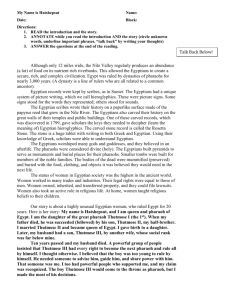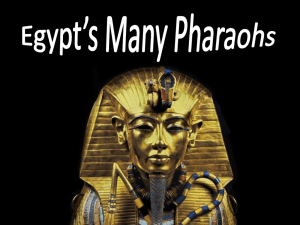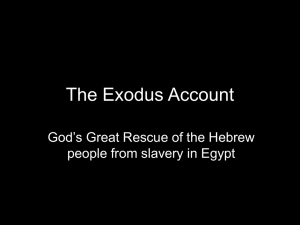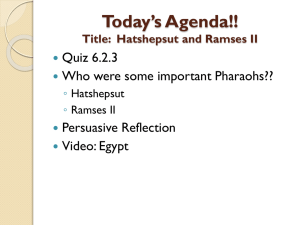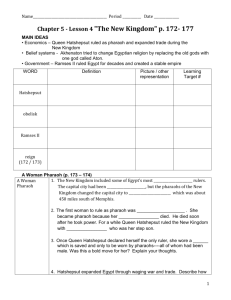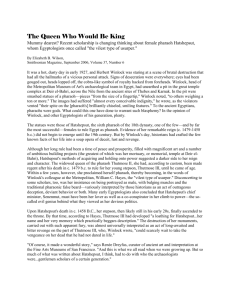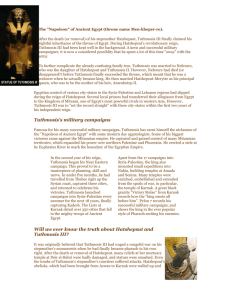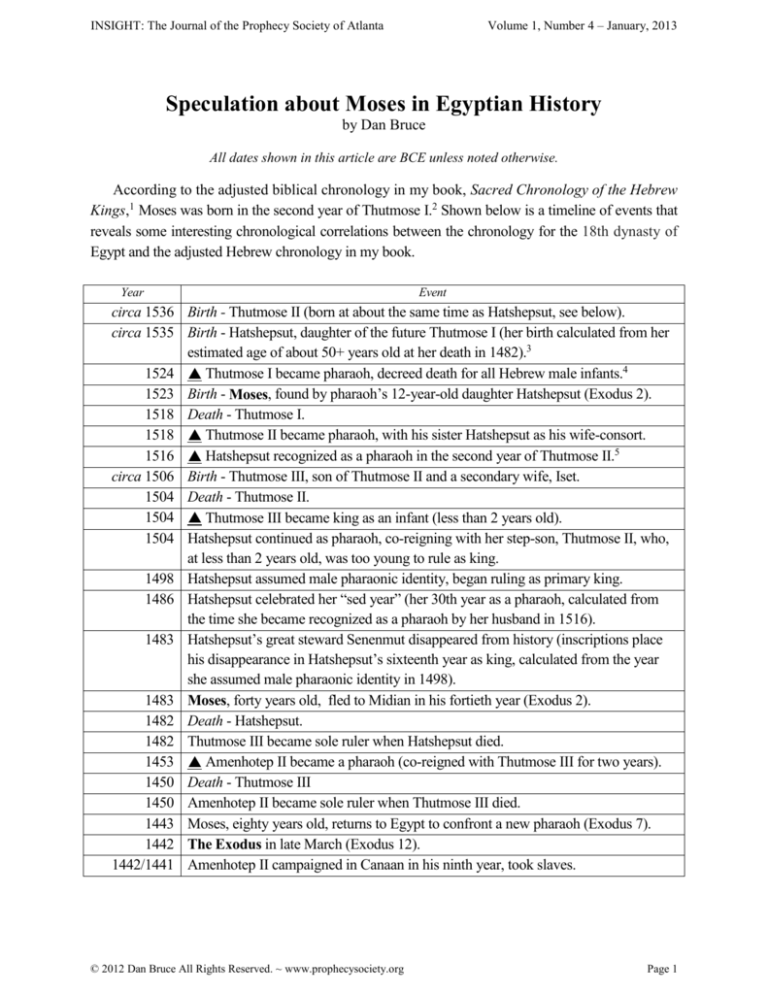
Volume 1, Number 4 – January, 2013
INSIGHT: The Journal of the Prophecy Society of Atlanta
Speculation about Moses in Egyptian History
by Dan Bruce
All dates shown in this article are BCE unless noted otherwise.
According to the adjusted biblical chronology in my book, Sacred Chronology of the Hebrew
Kings,1 Moses was born in the second year of Thutmose I.2 Shown below is a timeline of events that
reveals some interesting chronological correlations between the chronology for the 18th dynasty of
Egypt and the adjusted Hebrew chronology in my book.
Year
Event
circa 1536 Birth - Thutmose II (born at about the same time as Hatshepsut, see below).
circa 1535 Birth - Hatshepsut, daughter of the future Thutmose I (her birth calculated from her
estimated age of about 50+ years old at her death in 1482).3
1524 Thutmose I became pharaoh, decreed death for all Hebrew male infants.4
1523 Birth - Moses, found by pharaoh’s 12-year-old daughter Hatshepsut (Exodus 2).
1518 Death - Thutmose I.
1518 Thutmose II became pharaoh, with his sister Hatshepsut as his wife-consort.
1516 Hatshepsut recognized as a pharaoh in the second year of Thutmose II.5
circa 1506 Birth - Thutmose III, son of Thutmose II and a secondary wife, Iset.
1504 Death - Thutmose II.
1504 Thutmose III became king as an infant (less than 2 years old).
1504 Hatshepsut continued as pharaoh, co-reigning with her step-son, Thutmose II, who,
at less than 2 years old, was too young to rule as king.
1498 Hatshepsut assumed male pharaonic identity, began ruling as primary king.
1486 Hatshepsut celebrated her “sed year” (her 30th year as a pharaoh, calculated from
the time she became recognized as a pharaoh by her husband in 1516).
1483 Hatshepsut’s great steward Senenmut disappeared from history (inscriptions place
his disappearance in Hatshepsut’s sixteenth year as king, calculated from the year
she assumed male pharaonic identity in 1498).
1483 Moses, forty years old, fled to Midian in his fortieth year (Exodus 2).
1482 Death - Hatshepsut.
1482 Thutmose III became sole ruler when Hatshepsut died.
1453 Amenhotep II became a pharaoh (co-reigned with Thutmose III for two years).
1450 Death - Thutmose III
1450 Amenhotep II became sole ruler when Thutmose III died.
1443 Moses, eighty years old, returns to Egypt to confront a new pharaoh (Exodus 7).
1442 The Exodus in late March (Exodus 12).
1442/1441 Amenhotep II campaigned in Canaan in his ninth year, took slaves.
© 2012 Dan Bruce All Rights Reserved. ~ www.prophecysociety.org
Page 1
INSIGHT: The Journal of the Prophecy Society of Atlanta
Volume 1, Number 4 – January, 2013
Hypothesis: Thutmose I became pharaoh in the year 1,524. The new king decreed that all male
Hebrew infants be killed. The following year, 1,523, his twelve-year-old daughter Hatshepsut
rescued the infant Moses from the Nile River with the intention of raising him as a member of her
household. When Thutmose I died in 1,518, his son Thutmose II became pharaoh and the new
pharaoh’s half-sister Hatshepsut became his wife and queen. In the second year of Thutmose II’s
reign, according to your author's interpretation of an inscription on block 287 from the Chapelle
Rouge, a festival of Amen was celebrated during which Hatshepsut was recognized as a pharaoh,
circa 1516. During their co-reign, Thutmose II produced no male heir with Hatshepsut, but he did
sire a son, Thutmose III, with a secondary wife named Iset. When Thutmose II died in 1,504,
Hatshepsut continued as a pharaoh, at first sharing her reign with her step-son Thutmose III, who,
being less than two years old, was too young to rule. Seven years later, in 1,498, Hatshepsut assumed
a masculine public identity and reigned as king of Egypt for the next seventeen years, with her stepson Thutmose III serving in a subordinate role. Sometime after her recognition as pharaoh,
Hatshepsut elevated Senenmut to be her chief steward (top official),6 but Senenmut disappeared from
history in 1,483, about a year before Hatshepsut’s death. Senenmut exited from history at precisely
the same time that the biblical Moses fled to Midian after murdering an Egyptian, as recorded in
Exodus, chapter 2, verses 11-15. Did Moses kill Senenmut and then have to flee from Hatshepsut’s
wrath before returning to Egypt forty years later as the prophet Moses? That scenario would explain
why Moses, raised as a son of Hatshepsut and thus enjoying great privilege as son of the king, would
fear pharaoh for killing an Egyptian, in this case the king's most trusted advisor. Whatever the case,
the synchronizations between Egyptian chronology and history as known from inscriptions and the
Hebrew chronology and history as recounted in the Bible do reveal interesting correlations.
_____________________
Sacred Chronology of the Hebrew Kings (ISBN 978-0-9816912-3-7), with the entire text
available for reading online at no charge, click here.
2
Thutmose I was the first Egyptian king to have the nomen (birth name) Thutmose ḏḫwty-ms (born
of Thoth). Some have associated the name Moses with the last two hieroglyphs in the pharaoh’s
name, ms, which mean “bear” as in “bear a child,” and it is similar to the last syllables in the name
Ramose (born of Ra), which was the name of the father of Hatshepsut’s great steward Senenmut.
3
"Remains of pharaoh Queen Hatshepsut identified" USAToday.com (June 27, 2007;
http://usatoday30.usatoday.com/tech/science/discoveries/2007-06-27-egypt-queen_N.htm).
4 Aaron, born in 1526 (and thus three years older than Moses), was not included in the decree.
5
An inscription from the Chapelle Rouge, block 287, describes a festival of Amen during which
Hatshepsut is made a pharaoh unified with the Ka in the presence of and during the second year of an
unnamed king (traditionally assumed to be her father Thutmose I, but interpreted by your author to
be her husband Thutmose II instead, identifying her coronation as occurring in 1516).
6
Some scholars have speculated that Senenmut was Hatshepsut's lover. That is debatable, but
there can be no doubt that he was the power behind the throne and thus of prime importance to
the rule of Hatshepsut.
© 2012 Dan Bruce All Rights Reserved. ~ www.prophecysociety.org
Page 2
INSIGHT: The Journal of the Prophecy Society of Atlanta
Volume 1, Number 4 – January, 2013
About Us …
The Prophecy Society of Atlanta publishes books and papers about a widely-neglected
topic, sacred chronology, and provides access to Bible-based interpretations of chrono-specific
predictive prophecies that you may not have heard explained in your local church or synagogue.
When you examine our publications, you will quickly discover that the chronologies and
interpretations presented by the Society answer many of the questions left unanswered, or poorly
answered, in the study Bibles and biblical commentaries popular today. Our research and its
resulting scholarship are centered on the Bible, which we believe is the revealed word of the one
true Living God, and it is sustained by the belief that the Bible can be understood by anyone who
is genuinely seeking to understand it with an open mind and a seeking heart. We trust that you
will find our Bible-based discussions thought-provoking and spiritually enriching. If there is
anything you don't understand about our publications, ask us about it. We're here to help you as
you seek to understand the mind of God. … read more about us!
To purchase a copy of our books …
The Prophecy Society makes its books available at minimal cost through Amazon.com’s
CreateSpace publishing division, as follows:
Daniel Unsealed
An exposition revealing what the seven chrono-specific predictive prophecies in the Book of
Daniel say about the history of the Jews, Jerusalem, and the Anointed One of Israel.
Paperback, 224 pages (6 x 9); ISBN 978-1489505415. (click here)
Sacred Chronology of the Hebrew Kings
A harmony of the reigns of the kings of Israel and Judah, and how the chronologies and histories
of ancient Egypt and Mesopotamia synchronize with their reigns.
Paperback, 160 pages (6 x 9); ISBN 978-1489509048. (click here)
Synchronized Chronology
Synchronized Chronology of the Ancient Kingdoms of Israel, Judah, Egypt, Assyria, Tyre, and
Babylon from 1006 BCE to 560 BCE.
Paperback, 36 pages (8½ x 11); ISBN 978-1489557773. (click here)
© 2012 Dan Bruce All Rights Reserved. ~ www.prophecysociety.org
Page 3

